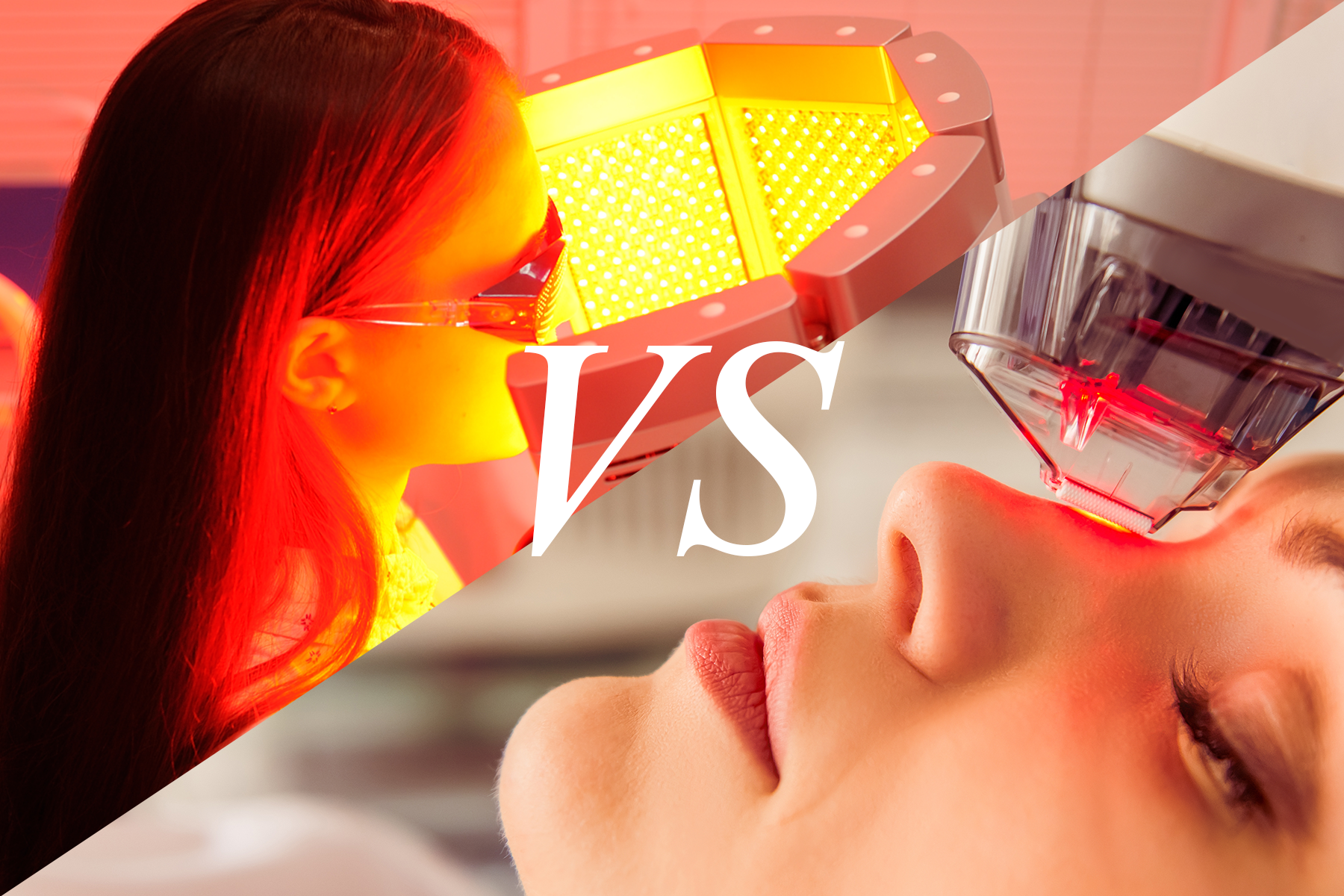The+Source
Light-emitting diode (or LED) treatments are one in-office skincare service that you can also do from the comfort of your couch. (Unlike Botox, for example, which you’re clearly not going to administer yourself while catching up on The Gilded Age.) Which begs the question: Do you even need to go to a dermatologist for an LED session?
After all, while credible home-use LED devices aren’t inexpensive (costing upward of $435), in-office services also aren’t cheap. (A single pro LED appointment can run from $25 to $85 or more.) However, there’s a time and place for both modalities, and a comprehensive skincare program includes each of them. Read on to see how to incorporate the two seamlessly into your regimen.
The two most common types of LEDs
First, you need to understand what you’re working with when it comes to LEDs for your face and body. While there are a range of LED wavelengths and colors that are believed to have skin benefits, there are really only two—red and blue—that are most often used in legitimate skincare treatments, whether done at home or in an office. (Not coincidentally, red and blue LEDs also have the most peer-reviewed, published research to back their efficacy.)
Red:
This wavelength is long enough to reach the top of the dermis, which is where the papillary fibroblasts reside. Red LEDs stimulate those fibroblasts, resulting in increased collagen production. Over time, you’ll notice a reduction in the appearance of fine lines, wrinkles, and hyperpigmentation. This type of LED also brings down inflammation, which immediately lessens both redness and pain.
Blue:
The output from blue LEDs doesn’t travel very far (just to the epidermis). But that’s far enough for them to accomplish their goal – wiping out p. acnes bacteria. Since proliferation of this type of bacteria is practically a guaranteed ticket to Breakout City, getting rid of p. acnes goes a long way toward ensuring clear skin.
Whether you choose red LEDs or blue, you can expect certain commonalities from your session: No downtime and zero pain or discomfort—either during the treatment or afterward.
In-office LEDs
Your dermatologist likely has a panel of red LEDs among their arsenal of lasers and other light-based devices. This is because 10 to 15 minutes in front of a glowing panel of red LEDs can almost immediately reduce the redness and inflammation that occur right after an in-office peel or laser session. (It’s pretty much a universal truth that patients would rather leave a doctor’s office without bright-red faces, even if they’re only temporary.)
You can also visit your derm for an LED dose, even if you aren’t getting it in tandem with another procedure. However, this is kind of like going to an aesthetician for a monthly facial. It’s nice and there’s certainly nothing wrong with it, but there’s also a reason your aesthetician sends you home with a list of recommended products – your daily regimen is where you can make a major impact on your skin. Which brings us to DIY devices.
At-home LEDs
Think of your at-home LED device the same way you do your sunscreen and retinol – an essential, unmissable part of your daily skincare routine. The same way that sporadic application of SPF and retinol will give you sub-par results, only using your LED device once in a blue moon will ensure you don’t achieve any meaningful (or noticeable) improvements.
Big Giant Caveat: LED devices are a dime a dozen these days. Which makes it even more critical that you check to be sure the tool you purchase is “FDA cleared.” (Drugs get FDA approval, but devices can only be cleared by the FDA.) Products that carry FDA clearance are guaranteed to deliver on their technology-based promises, when used as instructed. It’s not difficult to verify an item’s clearance claim. For one, the FDA maintains an online database of cleared devices. But also, getting FDA clearance is a (long, expensive) big deal! No brand that has it is going to hide that fact. Exhibit A: Both Dr. Dennis Gross DRx SpectraLite FaceWare Pro and Dr. Dennis Gross DRx SpectraLite BodyWare Pro have been FDA cleared! If you don’t see that designation mentioned anywhere in a product’s description, carefully consider what it means.
A main point of difference between what red LEDs can do when employed in a doctor’s office versus the results you’ll achieve with their consistent home use is that daily DIY red LED treatments can build collagen over time. You can’t just goad the fibroblasts once every 30 days and expect them to respond by making mountains of skin-plumping and -firming collagen. Instead, you need to give them a gentle reminder every single day. (The good news is this reminder can take as little as three minutes with the Dr. Dennis Gross DRx SpectraLite FaceWare Pro.)
Another benefit to an at-home LED system like the Dr. Dennis Gross DRx SpectraLite FaceWare Pro is that is also contains blue LEDs. If you feel a pimple forming on your face, it’s unlikely that you’ll have the time or inclination to drop everything and run to your dermatologist’s office for a dose of p. acnes-quashing blue LEDs. However, it’s not outside the realm of possibility to imagine yourself strapping on your Dr. Dennis Gross DRx SpectraLite FaceWare Pro for a quick three-minute blue LED sesh to keep that breakout at bay. Remember, prevention is key when treating acne. A daily blue LED treatment kills acne-causing bacteria before it even has a chance to turn into a breakout.







